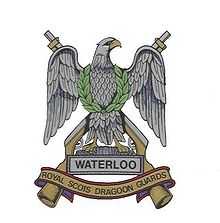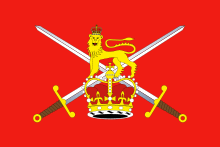Royal Scots Dragoon Guards
| The Royal Scots Dragoon Guards (Carabiniers and Greys) | |
|---|---|
|
Cap badge of the Royal Scots Dragoon Guards | |
| Active | 2 July 1971 – present |
| Allegiance |
|
| Branch |
|
| Type | Line cavalry |
| Role | Light Cavalry |
| Size | One regiment |
| Part of | Royal Armoured Corps |
| Garrison/HQ |
HHQ - Edinburgh Castle Regiment - Fallingbostel, Germany |
| Nickname | Scotland's Cavalry |
| Motto |
Nemo me impune lacessit (No one provokes me with impunity) Ich Dien (I Serve) Second to None |
| March |
Quick (band) - The 3DGs; (pipes & drums) - Hielan' Laddie Slow (band) - The Garb of Old Gaul; (pipes & drums) - My Home |
| Mascot | Drum Horse (Talavera) |
| Anniversaries |
13 April (Nunshigum) 18 June (Waterloo) 25 October (Balaklava) |
| Commanders | |
| Colonel-in-Chief | HM The Queen |
| Colonel of the Regiment | Brigadier S R B Allen |
| Insignia | |
| Tactical Recognition Flash |
|
| Arm Badge |
Prince of Wales's feathers from 3rd Dragoon Guards (Prince of Wales's) |
| Tartan | Royal Stewart (Pipers kilts and plaids) |
| Abbreviation | SCOTS DG |
The Royal Scots Dragoon Guards (Carabiniers and Greys) (SCOTS DG) is a cavalry regiment of the British Army, and the senior Scottish regiment. The regiment has won numerous battle honours and three Victoria Crosses, and, through the Royal Scots Greys, is the oldest surviving Cavalry Regiment of the Line in the British Army. The regiment is currently based in Bad Fallingbostel, British Forces Germany, as part of the 7th Armoured Brigade ('The Desert Rats').
History
It was formed on 2 July 1971 at Holyrood, Edinburgh, by the amalgamation of the 3rd Carabiniers (Prince of Wales's Dragoon Guards) (themselves the product of the amalgamation in 1922 of 3rd Dragoon Guards (Prince of Wales's) and 6th Dragoon Guards (Carabiniers)), and The Royal Scots Greys (2nd Dragoons).[1]
The regiment has deployed on four tours of Northern Ireland in 1972, 1974, 1976 and 1980, suffering one fatality in 1972, when Trooper Ian Hunter Caie, was killed by a bomb in a beer barrel that exploded in the path of his Ferret scout car in Moybane, near Crossmaglen County Armagh.[2]

It saw active service during the Gulf War in 1991 deploying 57 Challenger tanks[3] and in Bosnia as part of SFOR in 1996–97.[4]
In 1998, it became the first regiment in the British Army to operate the Challenger 2 main battle tank.[5]
It deployed to Kosovo, as part of KFOR, in 2000.[6]
The regiment deployed to Iraq for Operation Telic, the British element of the 2003 invasion of Iraq. The bulk of the regiment deployed as part of the Scots Dragoon Guards Battle Group with a single squadron (A Squadron) detached to the First Battalion The Black Watch Battle Group. All deployed elements of the regiment took part in the advance on Iraq's second largest city, Basra. Prior to reaching Basra, A Squadron fought in and around Az Zubayr and C Squadron was detached from the SCOTS DG BG to fight with 3 Commando Brigade in actions south of Basra that included Britain's largest tank engagement since the Gulf War, when 14 Challenger 2 tanks, engaged and destroyed 14 Iraqi tanks (the so-called '14–0' engagement).[7]
More recently in 2008, 2011 and 2013/14 the regiment deployed to Afghanistan.[8]
The pipes and drums have distinguished themselves, most recently winning the award for Album of the Year at the 2009 Classical Brits.[9]
In November 2013, the unit bade farewell to its Challenger 2 tanks and converted to a Light Cavalry unit, armed with Jackal vehicles.[10]
In the Army 2020 plan, it will be re-reroled to be a light cavalry unit, and will move to the Leuchars area.[11]
Current organisation

The regiment has converted to the role of light cavalry as part of restructuring in the army under Army 2020. It is now equipped with Jackal armoured fighting vehicles.[10]
The Royal Scots Dragoon Guards is also affiliated to A (Ayrshire (Earl of Carrick's Own) Yeomanry) & C (Fife and Forfar Yeomanry/Scottish Horse) Squadrons of the Queen's Own Yeomanry regiment of the Territorial Army.
Royal Scots Dragoon Guards Museum
The Royal Scots Dragoon Guards have a regimental museum situated at Edinburgh Castle.[12] Opened in 2006, the exhibits include uniforms, medals, weapons, regalia, music and a captured enemy standard from the Battle of Waterloo.
Official abbreviation
The regiment's official abbreviation (as listed in Joint Service Publication 101 (Service Writing)) is SCOTS DG (note all capitals and the space), the format of which follows the traditional Cavalry line whereby, for example, The 4th/7th Royal Dragoon Guards was abbreviated 4/7DG, and the Royal Scots Greys was abbreviated GREYS.
Accoutrements and uniform
The cap badge features an eagle, which represents the French Imperial Eagle that was captured by Sergeant Charles Ewart, the Royal Scots Greys at Waterloo, from the French 45th Regiment of Foot. It is always worn with a black backing in mourning for Tsar Nicholas II, the last Tsar of Russia, who was their Colonel-in-Chief at the time of his execution. The cap badge also has the crossed carbines of the 3rd Carabiniers at the rear of the eagle.
The Plume of The Prince of Wales with its motto "Ich Dien" is worn by all members of the Regiment embroidered on the upper part of the left sleeve. The right to wear this badge was granted to the 3rd Dragoon Guards in 1765, subsequently became the cap badge and later, with the crossed carabines, formed the badge of the 3rd Carabiniers (Prince of Wales's).
As a royal regiment, the Royal Scots Dragoon Guards is permitted to wear the Royal Stewart tartan, which was a privilege granted by HM King George VI, and is worn by the regiment's pipers. In addition, the Regiment's officers are permitted to wear the Black Stewart tartan. On informal occasions in their own Mess, officers may, at the discretion of the Commanding Officer, wear trews of Black Stewart tartan with their blue Undress tunics and also when in a civilian dinner jacket.
Traditions
The Loyal Toast is drunk at formal dinners in the Mess and is always drunk seated, except when Royalty is present. On evenings when a military band is present, besides playing "The Queen' the band also play "God Bless the Prince of Wales", an old 3rd Dragoon Guards custom, and the "Imperial Russian Anthem" in memory of Tsar Nicholas II, the Colonel-in-Chief of the Scots Greys, murdered during the Russian Revolution.
Regimental mottos
- The regimental motto is Nemo Me Impune Lacessit (No one provokes me with impunity), also the motto of the Order of the Thistle, to which it refers.
- The regiment also uses the motto "Second to None".
Pipes and Drums
The regiment has its own Pipes and Drums, who were first formed in 1946 and tour widely, performing in competitions, concerts and parades. Their most famous piece is "Amazing Grace", which reached number one in the charts in the United Kingdom, Ireland, Australia, New Zealand, Canada and South Africa in 1972. The track sold over seven million copies by mid 1977, and was awarded a gold disc.[13] The band released a new CD in late November 2007 through Universal Music, featuring a number of classic pipe tunes along with some modern arrangements and was recorded while the regiment was based in Iraq. The album Spirit Of The Glen was produced by Jon Cohen and released by Universal on 26 November 2007. Spirit Of The Glen was officially launched at Edinburgh Castle[14] and won Album of the Year at the 2009 Classical Brits.[9][15] They have also made regular appearances at the Royal Edinburgh Military Tattoo over the years.[16]
Order of precedence
| Preceded by 1st The Queen's Dragoon Guards |
Cavalry Order of Precedence | Succeeded by Royal Dragoon Guards |
Alliances
 Australia - 12th/16th Hunter River Lancers
Australia - 12th/16th Hunter River Lancers Canada - The Windsor Regiment (RCAC)
Canada - The Windsor Regiment (RCAC) New Zealand - The New Zealand Scottish
New Zealand - The New Zealand Scottish South Africa - The Natal Carbineers
South Africa - The Natal Carbineers Royal Navy - HMS Vengeance
Royal Navy - HMS Vengeance
Affiliated yeomanry
Battle honours
- [combined battle honours of 3rd Carabiniers and Royal Scots Greys, plus:]
- Wadi al Batin, Gulf 1991;[17] Al Basrah, Iraq 2003[18]
References
- ↑ "Royal Scots Dragoon Guards: History". Ministry of Defence. Retrieved 3 May 2014.
- ↑ "Sutton Index of Deaths". Cain.ulst.ac.uk. Retrieved 3 May 2014.
- ↑ "British Units in the Gulf War". Retrieved 3 May 2014.
- ↑ "Royal Scots Dragoon Guards launch £1m appeal to raise cash for injured comrades". Daily Record. 11 October 2011. Retrieved 3 May 2014.
- ↑ "Challenger 2". Hansard.millbanksystems.com. Retrieved 20 January 2015.
- ↑ Tank Spotter's Guide. Books.google.co.uk. p. 124. Retrieved 3 May 2014.
- ↑ "UK Operations - Iraq 2003". Pymes75.plus.com. Retrieved 3 May 2014.
- ↑ "The Serving Regiment". Scotsdgassn.org. Retrieved 3 May 2014.
- ↑ 9.0 9.1 "Classical Brits". Classicalbrits.co.uk. Retrieved 3 May 2014.
- ↑ 10.0 10.1 Ministry of Defence (2013-11-20). "Royal Scots Dragoon Guards receive new Jackal vehicles". GOV.UK. Retrieved 2014-05-03.
- ↑ "Regular Army Basing Plan - 5 Mar 2013" (PDF). Ministry of Defence. Retrieved 3 May 2014.
- ↑ "Scots DG, The Royal Scots Dragoon Guards, SCOTS DG Museum, Battle of waterloo - SCOTS DG Homepage". Scotsdgmuseum.com. Retrieved 2009-01-24.
- ↑ Murrells, Joseph (1978). The Book of Golden Discs (2nd ed.). London: Barrie and Jenkins Ltd. p. 320. ISBN 0-214-20512-6.
- ↑ "Scotland on TV - Videos about Scotland and all things Scottish". Scotlandontv.tv. Retrieved 3 May 2014.
- ↑ "Royal Scots Dragoon Guards band wins Classical Brit award". Daily Record. 15 May 2009. Retrieved 3 May 2014.
- ↑ "Scottish Regiments". Edinburgh Tattoo. Retrieved 3 May 2014.
- ↑ "Gulf Battle Honours". Hansard.millbansystems.com. Retrieved 20 January 2015.
- ↑ "House of Commons Hansard Written Ministerial Statements for 10 Nov 2005 (pt 1)". Publications.parliament.uk. Retrieved 20 January 2015.
Bibliography
- Nicoletti, Tony; Stephen, Aidan (2003). Shot and Captured: Photographs of the Royal Scots Dragoon Guards Battlegroup in Iraq 2003. Scottish Daily Record and Sunday Mail.
- Wood, Stephen (1988). In the Finest Tradition: The Royal Scots Dragoon Guards (Carabiniers & Greys): Its History and Treasures. Mainstream Pub. Co. ISBN 1-85158-174-X.
External links
| Wikimedia Commons has media related to Royal Scots Dragoon Guards. |
- "Official site".
- "Pipes & Drums site". Retrieved 14 May 2006.
- Official Universal Classics and Jazz Website
- "NPR Interview with Jon Cohen, Producer of Spirit of the Glen". Retrieved 11 November 2007.
- Royal Scots Dragoon Guards Museum
| ||||||||||||||||

